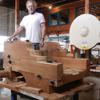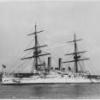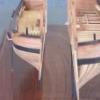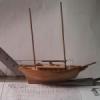-
Posts
3,353 -
Joined
-
Last visited
Reputation Activity
-
 Cathead got a reaction from ggrieco in USRC Ranger 1819 by Cathead – FINISHED – Corel – Scale 1:64
Cathead got a reaction from ggrieco in USRC Ranger 1819 by Cathead – FINISHED – Corel – Scale 1:64
Well, no worries, I've done my orders and now eagerly await better stuff to work with. In the meantime I have a busy work week and a spousal birthday on Saturday, so not much will likely get done soon anyway.
-
 Cathead got a reaction from ggrieco in USRC Ranger 1819 by Cathead – FINISHED – Corel – Scale 1:64
Cathead got a reaction from ggrieco in USRC Ranger 1819 by Cathead – FINISHED – Corel – Scale 1:64
Thanks to both of you. It's too bad I already did the deck blocks, but I also tended to choose the best of the lot for that job, so even after re-inspection I think they'll serve. Or I suppose I could cut 'em off and try my hand at attaching new ones straight to the rings. Hmmm. Anyway, it's the support network and the presence of actual builders/sellers like Chuck and other small businesses on here that make this such a great place (and yes, my membership in NRG is up-to-date so I'm not just saying that!).
While I wait for all this new stuff, I'll probably work on shaping the masts and rebuilding the cross-trees from scratch (another crappy metal piece I've given up on, and they should be wood anyway).
Matt, is M-E's rigging line any good? I ask because I have an unused credit there and budget is always a concern for me. I'm definitely ordering blocks from Syren.
-
 Cathead got a reaction from Larry Cowden in USRC Ranger 1819 by Cathead – FINISHED – Corel – Scale 1:64
Cathead got a reaction from Larry Cowden in USRC Ranger 1819 by Cathead – FINISHED – Corel – Scale 1:64
Well, would you look at that, now. I'd been all over the site but never thought to click on the actual blocks. Thank you, sir. Do you have an alert set up for your name or something? I thought of pming you but didn't want to waste your time with such a newbie question. An order will be forthcoming.
-
 Cathead got a reaction from ggrieco in USRC Ranger 1819 by Cathead – FINISHED – Corel – Scale 1:64
Cathead got a reaction from ggrieco in USRC Ranger 1819 by Cathead – FINISHED – Corel – Scale 1:64
I'm facing a challenge, which I hope one of you more experienced sorts can advise me on.
This kit has finally broken my desire to stick with the supplied materials. Both the blocks and belaying pins are near worthless, and the rigging line seems cheap. So I've decided to bite the bullet and order better stuff from Syren or an equivalent quality provider. But here's my dilemma: I don't know what size rigging line to order. Nowhere in the Corel instructions can I find a listing of the three line thicknesses they provide. And what really makes me paranoid is, I don't know how large the holes are in, say, the Syren blocks. So how do I determine what size line to buy, so that it's right and fits through good blocks? Any suggestions?
I found the line-size chart on Syren's website, which is nice, but it doesn't help me determine what will fit properly in different blocks. Help a newbie, please!
-
 Cathead got a reaction from Jack12477 in Heroine 1838 by ggrieco - FINISHED - Scale 1:24 - Western River Steamboat as she appeared before hitting a snag in the Red River
Cathead got a reaction from Jack12477 in Heroine 1838 by ggrieco - FINISHED - Scale 1:24 - Western River Steamboat as she appeared before hitting a snag in the Red River
He's a wizard, that's how. Glenndalf the Gre(at) walks among us.
-
 Cathead got a reaction from mtaylor in Guidance, Encouragement, or just a Sanity Check
Cathead got a reaction from mtaylor in Guidance, Encouragement, or just a Sanity Check
I'm 37 rather than 77, so it's easy for me to say Go For It, but I do. Think of it this way: most of our projects have value primarily to ourselves. Few of our models will ever be good enough, or unique enough, to matter much to other folks down the road. It's the process that matters, the joy and occupation and mental stimulation that we get out of pursuing these projects. If you never finish, whatever you've accomplished kept you interested and happy during that time, and that's what matters most. A complete or half-complete model will essentially be the same thing long enough down the road, though if you do complete it there will be that much more happiness in your life.
I've known, and known of, too many people that can't find anything productive or interesting to do with their time, retired or otherwise, and it makes me sad, as I feel I could have five lifetimes to explore all that I'm interested in. Think of the joy that it will bring, not only to yourself, but to all that care about you, that you have a project and a passion to interests and pleases you. Think of it as some of the cheapest health care you can find.
Go for it.
-
 Cathead reacted to ggrieco in Heroine 1838 by ggrieco - FINISHED - Scale 1:24 - Western River Steamboat as she appeared before hitting a snag in the Red River
Cathead reacted to ggrieco in Heroine 1838 by ggrieco - FINISHED - Scale 1:24 - Western River Steamboat as she appeared before hitting a snag in the Red River
Hello everyone,
Sorry for not being in touch for a while. I've had a string of very busy weekends for the Holidays and haven't had the chance to post anything. The last couple of weeks I've completed the last details that I needed to finish the Hurricane deck. Hopefully, I'll be able to apply the canvas to the deck this next week.
Originally, I was going to try to frame up the skylights with individual timbers but then I wondered if it could be milled from four solid panels. They turned out ok and it saved me a lot of time. The skylights on some of the early steamers were glazed with ground glass for privacy. I will be using sanded mica.
Front panel of the skylight in the mill.
Finished panels
Sorry, once again I should have dusted the parts before taking the photo.
There was probably a large galley stove on the main deck. Kevin chose this Wilson's patent stove to represent Heroine's.
Kevin's drawing of Heroine's galley stove.
Freshly milled parts. I used a block of walnut as a core for the stove.
Ceaned parts ready for soldering.
Finished galley stove.
Stove installed on main deck with firebrick lining and stovepipe.
One crushed stovepipe cap was recovered from the wreck.
Scale patterns for the stovepipe cap. The top piece was cut from .01 inch brass sheet.
To shape the cap I turned a piece of aluminum with the proper angle. Before shaping I heated the part to anneal it then I was able to easily shape it to the form without creases.
The uprights were filed from an appropriately sized brass tube.
Finished cap.
Cabin stove stovepipes blackened and capped. The larger galley stove pipe still needs to be blackened and capped.
-
 Cathead got a reaction from coxswain in Steamboats and other rivercraft - general discussion
Cathead got a reaction from coxswain in Steamboats and other rivercraft - general discussion
Apologies for misunderstanding your original question and jumping to conclusions; I should have asked for clarification first. Oh well, just a few more pixels spilled.
I wonder if some of the "dangling" in photos relates to the likelihood of these boats being photographed while pulled up on a levee where encounters with other boats were more likely. Certainly in Cap'n Bob's photo above, that boat is ashore and might well have another boat come alongside at any moment, so it makes sense to leave the fenders out even if the narrow photo view makes it look unnecessary. It would be interesting to compare photo sets and see if there's any correlation between onshore and underway in the arrangement of the fenders.
-
 Cathead got a reaction from coxswain in Steamboats and other rivercraft - general discussion
Cathead got a reaction from coxswain in Steamboats and other rivercraft - general discussion
Oh, interesting, I see how that could also match leclaire's description. The photos are certainly helpful. In that case I don't know, but your guess of bumpers does make sense, particularly for boats commonly pulled up in the close-packed confines of a busy levee like St. Louis.
-
 Cathead got a reaction from coxswain in Steamboats and other rivercraft - general discussion
Cathead got a reaction from coxswain in Steamboats and other rivercraft - general discussion
Bob,
It sounds to me like you're describing grasshopper spars, which were used to lever steamboats over/through particularly low-water places like sandbars. They were particularly common on rivers like the Missouri which were sediment-dominated (unlike the mostly bedrock Ohio and upper Mississippi), and thus so shallow that boats routinely got stuck but soft enough that doing so didn't rip their bottoms out. Here they are on my Bertrand, an 1865 boat from the Missouri River.
You can read a much more thorough description of their setup, purpose, and use in the Bertrand build log, which has a whole post dedicated just to this feature. Grasshopper spars were a key technological innovation that allowed boats to navigate the upper reaches of Great Plains rivers that would otherwise have been inaccessible to steamboats, and really mark a boat geographically.
The quick version of their function is that, yes, tney are free-swinging, but are linked to a steam winch/capstan. They hang from twin booms which can be positioned over the side of the bow as desired, and are then allowed to drop into the river, planting the dense, heavy poles into the sand. Then the winch is engaged, which tightens the lines running to the poles' tops, drawing the steamboat up out of the water as if on crutches. At the same time, the wheel is engaged to drive the boat forward (or backward, if needed), essentially levering the boat up and over (or off) the sandbar. This operation was repeated as needed until the boat was clear; the appearance of this repeated motion, and of the tall poles, gave the spars their name. These boats' hulls were so flexible (no equivalent keel to a sailing ship) that they could quite literally slither over a sand bar and back into deep water beyond. The spars gave the boat leverage at the bow to combine with the power at the stern (sternwheelers were most commonly fitted with these for upper river use, as sidewheelers generally couldn't handle conditions as shallow).
Does this match what you were asking about?
-
 Cathead reacted to Panama Port in Mississippi by Panama Port - OcCre - 1:80
Cathead reacted to Panama Port in Mississippi by Panama Port - OcCre - 1:80
The main deck is pretty much together. It may not stand up to close up scrutiny, but the effect is there. Hopefully the more visible areas will come out a little better. The side walls are removable so the interior can be shown.
Marv
-
 Cathead reacted to leclaire in Steamboats and other rivercraft - general discussion
Cathead reacted to leclaire in Steamboats and other rivercraft - general discussion
John and Cap'n Bob - Indeed, I was referring to those "hanging spars" shown in your photos. So they are there to provide extra protection while alongside in addition to the rubbing rail. Interesting how some were seen to be stowed away all ship shape while many others were just left to dangle. I imagine it all depended on the discipline or lack thereof from the master.
Cathead - I knew they were not the grasshopper spars primarily from following the excellent description in your Bertrand build log.
Many thanks to all,
Bob
-
 Cathead reacted to jbelwood in Steamboats and other rivercraft - general discussion
Cathead reacted to jbelwood in Steamboats and other rivercraft - general discussion
They are described to me as wooden fenders. Keeps the boats away from the pier no matter what level the
lake or river water is. Lower end placed on deck when underway.
John Elwood
-
 Cathead reacted to tlevine in make white preformed sails look better
Cathead reacted to tlevine in make white preformed sails look better
Consider replacing the plastic sails with cloth. I have used fine weave cotton saturated in starch and used the plastic sails as a mold to form new billowing sails.
-
 Cathead got a reaction from mattsayers148 in USS Constitution by CaptainSteve - Model Shipways - 1:76.8 scale
Cathead got a reaction from mattsayers148 in USS Constitution by CaptainSteve - Model Shipways - 1:76.8 scale
Thy patience has no bounds, good sir, nor thy fortitude in the face of such estimable challenges. As our dear bard once wrote, "How poor are they that have not patience? What would did ever heal but by degrees?"
-
 Cathead got a reaction from Canute in Steamboats and other rivercraft - general discussion
Cathead got a reaction from Canute in Steamboats and other rivercraft - general discussion
Bob,
It sounds to me like you're describing grasshopper spars, which were used to lever steamboats over/through particularly low-water places like sandbars. They were particularly common on rivers like the Missouri which were sediment-dominated (unlike the mostly bedrock Ohio and upper Mississippi), and thus so shallow that boats routinely got stuck but soft enough that doing so didn't rip their bottoms out. Here they are on my Bertrand, an 1865 boat from the Missouri River.
You can read a much more thorough description of their setup, purpose, and use in the Bertrand build log, which has a whole post dedicated just to this feature. Grasshopper spars were a key technological innovation that allowed boats to navigate the upper reaches of Great Plains rivers that would otherwise have been inaccessible to steamboats, and really mark a boat geographically.
The quick version of their function is that, yes, tney are free-swinging, but are linked to a steam winch/capstan. They hang from twin booms which can be positioned over the side of the bow as desired, and are then allowed to drop into the river, planting the dense, heavy poles into the sand. Then the winch is engaged, which tightens the lines running to the poles' tops, drawing the steamboat up out of the water as if on crutches. At the same time, the wheel is engaged to drive the boat forward (or backward, if needed), essentially levering the boat up and over (or off) the sandbar. This operation was repeated as needed until the boat was clear; the appearance of this repeated motion, and of the tall poles, gave the spars their name. These boats' hulls were so flexible (no equivalent keel to a sailing ship) that they could quite literally slither over a sand bar and back into deep water beyond. The spars gave the boat leverage at the bow to combine with the power at the stern (sternwheelers were most commonly fitted with these for upper river use, as sidewheelers generally couldn't handle conditions as shallow).
Does this match what you were asking about?
-
 Cathead got a reaction from dgbot in Steamboats and other rivercraft - general discussion
Cathead got a reaction from dgbot in Steamboats and other rivercraft - general discussion
Bob,
It sounds to me like you're describing grasshopper spars, which were used to lever steamboats over/through particularly low-water places like sandbars. They were particularly common on rivers like the Missouri which were sediment-dominated (unlike the mostly bedrock Ohio and upper Mississippi), and thus so shallow that boats routinely got stuck but soft enough that doing so didn't rip their bottoms out. Here they are on my Bertrand, an 1865 boat from the Missouri River.
You can read a much more thorough description of their setup, purpose, and use in the Bertrand build log, which has a whole post dedicated just to this feature. Grasshopper spars were a key technological innovation that allowed boats to navigate the upper reaches of Great Plains rivers that would otherwise have been inaccessible to steamboats, and really mark a boat geographically.
The quick version of their function is that, yes, tney are free-swinging, but are linked to a steam winch/capstan. They hang from twin booms which can be positioned over the side of the bow as desired, and are then allowed to drop into the river, planting the dense, heavy poles into the sand. Then the winch is engaged, which tightens the lines running to the poles' tops, drawing the steamboat up out of the water as if on crutches. At the same time, the wheel is engaged to drive the boat forward (or backward, if needed), essentially levering the boat up and over (or off) the sandbar. This operation was repeated as needed until the boat was clear; the appearance of this repeated motion, and of the tall poles, gave the spars their name. These boats' hulls were so flexible (no equivalent keel to a sailing ship) that they could quite literally slither over a sand bar and back into deep water beyond. The spars gave the boat leverage at the bow to combine with the power at the stern (sternwheelers were most commonly fitted with these for upper river use, as sidewheelers generally couldn't handle conditions as shallow).
Does this match what you were asking about?
-
 Cathead reacted to captainbob in Steamboats and other rivercraft - general discussion
Cathead reacted to captainbob in Steamboats and other rivercraft - general discussion
I believe he is asking about the 6 X 6 beams the hang from the boiler deck as in these pictures. I've always thought they were bumpers.
Bob
Here you can see them hanging along the side.
Here they are pulled up so the ends are on deck.
-
 Cathead got a reaction from mtaylor in USS Constitution by CaptainSteve - Model Shipways - 1:76.8 scale
Cathead got a reaction from mtaylor in USS Constitution by CaptainSteve - Model Shipways - 1:76.8 scale
Thy patience has no bounds, good sir, nor thy fortitude in the face of such estimable challenges. As our dear bard once wrote, "How poor are they that have not patience? What would did ever heal but by degrees?"
-
 Cathead reacted to CaptainSteve in USS Constitution by CaptainSteve - Model Shipways - 1:76.8 scale
Cathead reacted to CaptainSteve in USS Constitution by CaptainSteve - Model Shipways - 1:76.8 scale
It hath been way too long since CaptainSteve didst update-eth this log. Verily, some o’ Ye may even be a-thinkin’ that he didst chuck-eth in the towel and give-eth up on this build.
“Nothing,” declared Our Hero, stirring from semi-retirement, “couldst be further from the Truth.”
“Indeed-eth,” he were to go on, by way of explanation, “’Tis true that I may ha’ thrown a tantrum or two when me stern timber didst snap-peth. But that couldst easily ha’ been repaired.”
However, ‘twas whilst Our Hero was examining the damage done, a-scratching his head and contemplating his options, that he were to notice something that didst cause-eth him great consternation.
“Forsooth,” he were to begin. “I crap-peth thee not, but I were to discover-eth a most foul emission which I didst maketh.“
A most foul emission, you say, CaptainSteve ?? No surprises there !!
“A most foul O-mission, I didst mean-eth”, Our Hero were to haughtily correct-eth himself. “For, verily, ‘twouldst seem-eth that I didst neglect to work-eth in the curvature across Connie’s sternal regions.”
Indeed, the counter piece which had been made previously (and made-over, and over) were too short and the upright timbers didst result in a flat plane when taken horizontally across the stern. But, upon re-examining the plans and his vast collection of Connie cornucopia, it became clear that this were not to be the case … a slight outward curvature didst exist and was glaringly apparent.
“Besides,“ CaptainSteve didst interdict, if further justification were necessary, “She looks better that way !!”
And, so, yet another do-over were to be in order ... a major one, this time.
“Verily, backward steps were taken …”, Our Hero didst declare-eth.
Thusly, he were to take-eth up his knife and didst remove-eth the timbers a-ready inserted, and he didst return-eth unto the drawing board.
Stay tuned, Dear Reader. An update be imminent …
-
 Cathead got a reaction from cog in Steamboats and other rivercraft - general discussion
Cathead got a reaction from cog in Steamboats and other rivercraft - general discussion
Sal,
That's a neat prototype, to be sure. Just to clarify, the placement of the paddle wheels isn't diagnostic of the boat's design or location. Western river boats used both stern and side wheel designs, as each has its benefits and drawbacks.
Stern wheels were generally better for shallow or snag-filled water, as the hull protected the wheel, whereas side wheels were quite susceptible to damage being exposed on the sides. In addition, stern wheels could be used to help a boat cross shallow bars or back off muddy shorelines; setting the wheel in reverse forced lots of water under the hull, "floating" it off an obstacle.
On the other hand, side wheels were more maneuverable, as they could be independently stopped or run in opposite directions, spinning the boat in place (at least on later designs with separate engines for each wheel). They also distributed the weight of machinery closer to the center of the vessel, reducing the "hogging" so common on stern wheel designs.
For rivers like the Hudson, which were deep and tame compared to the western rivers, side wheelers made a lot more sense, so that's what you mostly see. This is also true of the lower Mississippi, below the confluence of the Missouri and Ohio rivers into the main stem. But you saw a lot more stern wheelers as you went upstream to the upper Ohio and Missouri rivers in particular, and their smaller tributaries.
This is also the case because the western rivers, especially the Missouri, tended to have a lot of debris in them because their basins' geology wasn't as dominated by bedrock. Banks were always eroding away in huge chunks, dropping wads of trees into the river, and changing the rivers' courses regularly. By contrast, most eastern rivers like the Hudson are bedrock-dominated; they don't change course much at all and they don't erode their banks in the same way, so they tended to be "cleaner" of debris with more stable channels, negating the main benefits of stern wheel designs. So you tended to see side wheelers in the east, and a mix of the two in the West depending on where the boat's main work was intended to be (and various other factors, it's not quite this cut and dry).
This is a broad overview, there are many per-river details that I could write a small book on. But hopefully that clarifies part of the question. Personally I don't have any resources to suggest about walking-beam engines, but hopefully someone else does. I've seen examples on craft from various parts of the world, so hope that someone else here can help you out. I hope you can find resources specific to eastern boats, as the designs and construction will be pretty different from the western boats, due to differences in materials, industrial capacity, design philosophy, and river conditions between the two regions. But the placement of the wheels, on its own, isn't a factor.
-
 Cathead got a reaction from thibaultron in make white preformed sails look better
Cathead got a reaction from thibaultron in make white preformed sails look better
I used artist's pastels on a few plastic models, such as in my avatar. It came out nicely and the pastel grain gives the surface some texture that helps obscure the plastic sheen.
-
 Cathead got a reaction from Canute in make white preformed sails look better
Cathead got a reaction from Canute in make white preformed sails look better
I used artist's pastels on a few plastic models, such as in my avatar. It came out nicely and the pastel grain gives the surface some texture that helps obscure the plastic sheen.
-
 Cathead got a reaction from Tadeusz43 in Steamboats and other rivercraft - general discussion
Cathead got a reaction from Tadeusz43 in Steamboats and other rivercraft - general discussion
Bob,
It sounds to me like you're describing grasshopper spars, which were used to lever steamboats over/through particularly low-water places like sandbars. They were particularly common on rivers like the Missouri which were sediment-dominated (unlike the mostly bedrock Ohio and upper Mississippi), and thus so shallow that boats routinely got stuck but soft enough that doing so didn't rip their bottoms out. Here they are on my Bertrand, an 1865 boat from the Missouri River.
You can read a much more thorough description of their setup, purpose, and use in the Bertrand build log, which has a whole post dedicated just to this feature. Grasshopper spars were a key technological innovation that allowed boats to navigate the upper reaches of Great Plains rivers that would otherwise have been inaccessible to steamboats, and really mark a boat geographically.
The quick version of their function is that, yes, tney are free-swinging, but are linked to a steam winch/capstan. They hang from twin booms which can be positioned over the side of the bow as desired, and are then allowed to drop into the river, planting the dense, heavy poles into the sand. Then the winch is engaged, which tightens the lines running to the poles' tops, drawing the steamboat up out of the water as if on crutches. At the same time, the wheel is engaged to drive the boat forward (or backward, if needed), essentially levering the boat up and over (or off) the sandbar. This operation was repeated as needed until the boat was clear; the appearance of this repeated motion, and of the tall poles, gave the spars their name. These boats' hulls were so flexible (no equivalent keel to a sailing ship) that they could quite literally slither over a sand bar and back into deep water beyond. The spars gave the boat leverage at the bow to combine with the power at the stern (sternwheelers were most commonly fitted with these for upper river use, as sidewheelers generally couldn't handle conditions as shallow).
Does this match what you were asking about?
-
 Cathead got a reaction from mtaylor in make white preformed sails look better
Cathead got a reaction from mtaylor in make white preformed sails look better
I used artist's pastels on a few plastic models, such as in my avatar. It came out nicely and the pastel grain gives the surface some texture that helps obscure the plastic sheen.












